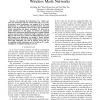Free Online Productivity Tools
i2Speak
i2Symbol
i2OCR
iTex2Img
iWeb2Print
iWeb2Shot
i2Type
iPdf2Split
iPdf2Merge
i2Bopomofo
i2Arabic
i2Style
i2Image
i2PDF
iLatex2Rtf
Sci2ools
ICC
2007
IEEE
2007
IEEE
Characterizing and Exploiting Partial Interference in Wireless Mesh Networks
Abstract-- In evaluating the performance of a wireless network, the interference between wireless links plays a key role. In previous works, interference was assumed to be a binary phenomenon, i.e., either the links mutually interfere with each other, or they do not interfere. However, there were experimental results contradicting this binary assumption. We term this as partial interference. In this paper, we present an analytical framework to characterize partial interference in a single-channel wireless network under unsaturated traffic conditions, and use 802.11b with basic access scheme and differential binary phase shift keying as an illustration. An analogy is drawn between partial interference and code division multiple access to demonstrate their similarities. The gain in capacity across unit cut by exploiting partial interference can be as high as 67% under scheduling in a modified Manhattan network.
| Added | 16 Aug 2010 |
| Updated | 16 Aug 2010 |
| Type | Conference |
| Year | 2007 |
| Where | ICC |
| Authors | Ka-Hung Hui, Wing Cheong Lau, On-Ching Yue |
Comments (0)

